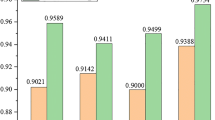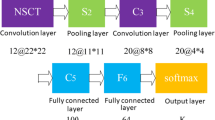Abstract
With advances in social development and economic growth, remote sensing technology has been attracted greater attention in monitoring the earth data using radar and optical sensors on satellite platforms for a wide range of applications in different fields such as coastal, hazard and natural resources. Satellite images could play a greater role in improving classification accuracy with high spatial resolution and rich spectral information for land cover classification. However, existing image fusion methods achieves low accuracy due to large-scale feature space. To focus on these issues, a deep learning network structure needs to classify different classes with high spatial resolution and rich spectral information to obtain higher accuracy. In this paper, a feature-based classification approach is proposed namely Multi-Fusion based Dense Transpose Convolutional layer in Fully Convolutional Network with Feature Alignment framework (MF-DTCFCN) to label and categorizes the label region in Remote Sensing Images (RSI). Initially, a multi-fusion feature framework is designed by adding a point-wise addition structure to handle large-scale feature space for high-resolution images. Secondly, the optimized features are pre-trained to classify the labels comprised of the most discriminative features in the pre-training network. The density of output label maps are improved by introducing dense transpose convolution in the network. Then combine the output to the feature alignment with point-wise addition is employed to balance the different features and similarities to achieve additional performance for classification. Here, the Land Use/land Cover (LULC) satellite image dataset namely, Sentinel-2 were used to classify the urban areas of Hyderabad city, India. Experimental results depict that the MF-DTCFCN approach outperforms an accurate improvement in classification accuracy than existing methods.













Similar content being viewed by others
References
Ahmad RF, Malik AS, Qayyum A, Kamel N (2015) Disaster monitoring in urban and remote areas using satellite stereo images: A depth estimation approach, In 2015 IEEE 11th International Colloquium on Signal Processing Its Applications (CSPA) (pp, 150–155) IEEE
Aslami F, Ghorbani A (2018) Object-based land-use/land-cover change detection using Landsat imagery: a case study of Ardabil Namin and Nir counties in northwest Iran. Environ Monit Assess 190(7):1–14
Breiman L, Friedman JH, Olshen RA, Stone CJ (2017) Classification and regression trees. Routledge
Chapelle O, Haffner P, Vapnik VN (1999) Support vector machines for histogram-based image classification. IEEE Trans Neural Netw 10(5):1055–1064
Cui X, Zhang W, Tüske Z, Picheny M (2018) Evolutionary stochastic gradient descent for optimization of deep neural networks, arXiv preprint arXiv:1810,06773
Drusch M, Del Bello U, Carlier S, Colin O, Fernandez V, Gascon F, Hoersch B, Isola C, Laberinti P, Martimort P (2012) Sentinel-2: ESA’s optical high-resolution mission for GMES operational services. Remote Sens Environ 120:25–36
Fernandez-Beltran R, Haut JM, Paoletti ME, Plaza J, Plaza A, Pla F (2018) Remote sensing image fusion using hierarchical multimodal probabilistic latent semantic analysis. IEEE J Select Topics Appl Earth Observ Remote Sens 11(12):4982–4993
Ghassemian H (2016) A review of remote sensing image fusion methods. Information Fusion 32:75–89
Gómez-Chova L, Tuia D, Moser G, Camps-Valls G (2015) Multimodal classification of remote sensing images: A review and future directions. Proc IEEE 103(9):1560–1584
Graves A, Schmidhuber J (2005) Framewise phoneme classification with bidirectional LSTM and other neural network architectures. Neural Netw 18(5–6):602–610
Gu Q, Li Z, Han J (2012) Generalized fisher score for feature selection, arXiv preprint arXiv:1202,3725
Han W, Feng R, Wang L, Cheng Y (2018) A semi-supervised generative framework with deep learning features for high-resolution remote sensing image scene classification. ISPRS J Photogramm Remote Sens 145:23–43
Herman G, Zhang B, Wang Y, Ye G, Chen F (2013) Mutual information-based method for selecting informative feature sets. Pattern Recogn 46(12):3315–3327
Hong D, Yokoya N, Xia G, S, Chanussot J, Zhu XX (2020) X-ModalNet: A semi-supervised deep cross-modal network for classification of remote sensing data, ISPRS Journal of Photogrammetry and Remote Sensing 167:12-23
Jin B, Ye P, Zhang X, Song W, Li S (2019a) Object-oriented method combined with deep convolutional neural networks for land-use-type classification of remote sensing images. J Indian Soc Remote Sens 47(6):951–965
Jin Z, Min L, Ng MK, Zheng M (2019b) Image colorization by fusion of color transfers based on DFT and variance features. Comput Math Appl 77(9):2553–2567
Kadavi PR, Lee CW (2018) Land cover classification analysis of volcanic island in Aleutian Arc using an artificial neural network (ANN) and a support vector machine (SVM) from Landsat imagery. Geosci J 22(4):653–665
Li F, Miao D, Pedrycz W (2017) Granular multi-label feature selection based on mutual information. Pattern Recogn 67:410–423
Li G, Li L, Zhu H, Liu X, Jiao L (2019) Adaptive multiscale deep fusion residual network for remote sensing image classification. IEEE Trans Geosci Remote Sens 57(11):8506–8521
Lu X, Zheng X, Yuan Y (2017) Remote sensing scene classification by unsupervised representation learning. IEEE Trans Geosci Remote Sens 55(9):5148–5157
Lyons MB, Keith DA, Phinn SR, Mason TJ, Elith J (2018) A comparison of resampling methods for remote sensing classification and accuracy assessment. Remote Sens Environ 208:145–153
Ma C, Mu X, Sha D (2019) Multi-layers feature fusion of convolutional neural network for scene classification of remote sensing. IEEE Access 7:121685–121694
Ma J, Zhou H, Zhao J, Gao Y, Jiang J, Tian J (2015) Robust feature matching for remote sensing image registration via locally linear transforming. IEEE Trans Geosci Remote Sens 53(12):6469–6481
Maggiori E, Tarabalka Y, Charpiat G, Alliez P (2016) Convolutional neural networks for large-scale remote-sensing image classification. IEEE Trans Geosci Remote Sens 55(2):645–657
Man Q, Dong P, Guo H (2015) Pixel-and feature-level fusion of hyperspectral and lidar data for urban land-use classification. Int J Remote Sens 36(6):1618–1644
Martins VS, Kaleita AL, Gelder BK, da Silveira HL, Abe CA (2020) Exploring multiscale object-based convolutional neural network (multi-OCNN) for remote sensing image classification at high spatial resolution. ISPRS J Photogramm Remote Sens 168:56–73
Mironică I, Ionescu B, Uijlings J, Sebe N (2016) Fisher kernel temporal variation-based relevance feedback for video retrieval. Comput vis Image Underst 143:38–51
Palmer SC, Kutser T, Hunter PD (2015) Remote sensing of inland waters: Challenges progress and future directions
Peng J, Sun W, Ma L, Du Q (2019) Discriminative transfer joint matching for domain adaptation in hyperspectral image classification. IEEE Geosci Remote Sens Lett 16(6):972–976
Peterson LE, Larin KV (2009) Image classification of artificial fingerprints using Gabor wavelet filters, self-organising maps and Hermite/Laguerre neural networks. Intl J Knowl Eng Soft Data Paradigms 1(3):239–256
Schmitt M, Zhu XX (2016) Data fusion and remote sensing: An ever-growing relationship. IEEE Geosci Remote Sens Magazine 4(4):6–23
Sharma A, Liu X, Yang X (2018) Land cover classification from multi-temporal multi-spectral remotely sensed imagery using patch-based recurrent neural networks. Neural Netw 105:346–355
Solanky V, Katiyar SK (2016) Pixel-level image fusion techniques in remote sensing: a review. Spat Inf Res 24(4):475–483
Such FP, Sah S, Dominguez MA, Pillai S, Zhang C, Michael A, Ptucha R (2017) Robust spatial filtering with graph convolutional neural networks. IEEE J Select Topics Signal Process 11(6):884–896
Tong XY, Xia GS, Lu Q, Shen H, Li S, You S, Zhang L (2020) Land-cover classification with high-resolution remote sensing images using transferable deep models. Remote Sens Environ 237:111322
Toth C, Jóźków G (2016) Remote sensing platforms and sensors: A survey. ISPRS J Photogramm Remote Sens 115:22–36
Visin F, Kastner K, Cho K, Matteucci M, Courville A, Bengio Y (2015) Renet: A recurrent neural network based alternative to convolutional networks. arXiv preprint arXiv:1505.00393
Vohra R, Tiwari KC (2018) Object based classification using multisensor data fusion and support vector algorithm. Int J Image Data Fusion 9(1):63–81
Wang G, Fan B, Xiang S, Pan C (2017) Aggregating rich hierarchical features for scene classification in remote sensing imagery. IEEE J Select Topics Appl Earth Observ Remote Sens 10(9):4104–4115
Wang Q, Yuan Z, Du Q, Li X (2018) GETNET: A general end-to-end 2-D CNN framework for hyperspectral image change detection. IEEE Trans Geosci Remote Sens 57(1):3–13
Weng Q, Mao Z, Lin J, Liao X (2018) Land-use scene classification based on a CNN using a constrained extreme learning machine. Int J Remote Sens 39(19):6281–6299
Wosiak A, Zakrzewska D (2017) Unsupervised feature selection using reversed correlation for improved medical diagnosis, In 2017 IEEE international conference on INnovations in Intelligent SysTems and Applications (INISTA) IEEE 18–22
Yuan J, Niu Z (2008) Evaluation of atmospheric correction using FLAASH. In2008 International Workshop on Earth Observation and Remote Sensing Applications, IEEE 1–6
Zhang C, Yue P, Tapete D, Shangguan B, Wang M, Wu Z (2020) A multi-level context-guided classification method with object-based convolutional neural network for land cover classification using very high resolution remote sensing images. Int J Appl Earth Obs Geoinf 88:102086
Zhang J, Li T, Lu X, Cheng Z (2016) Semantic classification of high-resolution remote-sensing images based on mid-level features. IEEE J Select Topics Appl Earth Observ Remote Sens 9(6):2343–2353
Zhang Q, Liu Y, Blum RS, Han J, Tao D (2018) Sparse representation based multi-sensor image fusion for multi-focus and multi-modality images: A review. Information Fusion 40:57–75
Zhang W, Sun X, Wang H, Fu K (2015) A generic discriminative part-based model for geospatial object detection in optical remote sensing images. ISPRS J Photogramm Remote Sens 99:30–44
Zhao W, Du S (2016) Spectral–spatial feature extraction for hyperspectral image classification: A dimension reduction and deep learning approach. IEEE Trans Geosci Remote Sens 54(8):4544–4554
Author information
Authors and Affiliations
Contributions
All the authors have participated in writing the manuscript and have revised the final version. All authors read and approved the final manuscript.
Corresponding author
Ethics declarations
Ethical approval
This article does not contain any studies with human participants and/or animals performed by any of the authors.
Conflict of Interest
Authors declares that they have no conflict of interest.
Informed consent
There is no informed consent for this study.
Additional information
Communicated by H. Babaie.
Publisher's note
Springer Nature remains neutral with regard to jurisdictional claims in published maps and institutional affiliations.
Rights and permissions
Springer Nature or its licensor (e.g. a society or other partner) holds exclusive rights to this article under a publishing agreement with the author(s) or other rightsholder(s); author self-archiving of the accepted manuscript version of this article is solely governed by the terms of such publishing agreement and applicable law.
About this article
Cite this article
Vohra, R., Tiwari, K.C. Land cover classification using multi-fusion based dense transpose convolution in fully convolutional network with feature alignment for remote sensing images. Earth Sci Inform 16, 983–1003 (2023). https://doi.org/10.1007/s12145-022-00891-8
Received:
Accepted:
Published:
Issue Date:
DOI: https://doi.org/10.1007/s12145-022-00891-8




